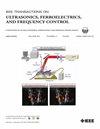单SAWR传感器系统监测动态应变和温度。
IF 3.7
2区 工程技术
Q1 ACOUSTICS
IEEE transactions on ultrasonics, ferroelectrics, and frequency control
Pub Date : 2025-07-28
DOI:10.1109/TUFFC.2025.3593192
引用次数: 0
摘要
在工业环境中,动态应变和温度是需要监测的关键物理量,以确保安全的操作条件,并为所需的维护进行诊断。动态应变和温度反馈信号对于航空航天、汽车、发电和先进制造业中的设备和结构健康监测应用尤为重要。动态应变传感面临的挑战包括传感器粘附、封装、稳定性和温度交叉灵敏度。表面声波谐振器(SAWR)传感器已经证明了在各种工业/恶劣环境条件下监测温度、应变、振动、气体和中子通量等量的能力。SAWR传感器的额外优点是尺寸紧凑,能够无线和无电池操作。为了进一步探索SAWR器件和传感器的多功能性,本文报道了使用功率谱技术同时测量温度和动态应变的单个SAWR器件的利用。由于SAWR对动态应变的灵敏度也依赖于温度,因此利用SAWR本身固有的温度传感能力为选择合适的应变传感器校准曲线提供了一种极好的方法。一旦温度已知并选择合适的应变校准曲线,就可以从SAWR动态应变谱分量相对于主共振峰的相对幅值实时跟踪应变幅值。为了验证该方法,首先对sar进行了室温至190℃范围内的温度和动态应变校准,并进行了11至26 με的500 Hz动态应变测试信号。对于大于100°C的温度,sar测量温度的精度保持在参考热电偶的2°C以内,与商用应变计相比,总体应变差异小于4%。本文章由计算机程序翻译,如有差异,请以英文原文为准。
A Single SAWR Sensor System to Monitor Both Dynamic Strain and Temperature
Dynamic strain and temperature are critical physical quantities to be monitored in industrial environments to assure safe operational conditions and to diagnose for required maintenance. Dynamic strain and temperature feedback signals are particularly important for equipment and structural health monitoring (SHM) applications in aerospace, automotive, power generation, and advanced manufacturing. Challenges presented by dynamic strain sensing include sensor adhesion, packaging, stability, and temperature cross-sensitivity. Surface acoustic wave resonator (SAWR) sensors have demonstrated the ability to function under a variety of industrial/harsh environmental conditions for monitoring quantities, such as temperature, strain, vibration, gases, and neutron flux. SAWR sensors have the added benefits of being compact in size and capable of wireless and battery-free operation. In further exploring the versatility of SAWR devices and sensors, this article reports on the utilization of a single SAWR device that can simultaneously measure temperature and dynamic strain using a power spectral technique. Since the SAWR sensitivity to dynamic strain is also dependent on temperature, using the inherent temperature sensing capability of the SAWR itself offers an excellent method for selecting the appropriate strain sensor calibration curve. Once the temperature is known and the appropriate strain calibration curve is selected, real-time tracking of the strain magnitude can then be obtained from the relative amplitude of the SAWR dynamic strain spectral components to the main resonant peak. To demonstrate this method, SAWRs were initially calibrated for temperature and dynamic strain from room temperature (RT) to 190 °C and subjected to 500 Hz dynamic strain test signals ranging from 11 to $26~\mu \varepsilon $ . The accuracy of the SAWR-measured temperature remains within 2 °C of a reference thermocouple for temperatures greater than 100 °C, resulting in an overall strain discrepancy of less than 4% when compared to a commercial strain gauge.
求助全文
通过发布文献求助,成功后即可免费获取论文全文。
去求助
来源期刊
CiteScore
7.70
自引率
16.70%
发文量
583
审稿时长
4.5 months
期刊介绍:
IEEE Transactions on Ultrasonics, Ferroelectrics and Frequency Control includes the theory, technology, materials, and applications relating to: (1) the generation, transmission, and detection of ultrasonic waves and related phenomena; (2) medical ultrasound, including hyperthermia, bioeffects, tissue characterization and imaging; (3) ferroelectric, piezoelectric, and piezomagnetic materials, including crystals, polycrystalline solids, films, polymers, and composites; (4) frequency control, timing and time distribution, including crystal oscillators and other means of classical frequency control, and atomic, molecular and laser frequency control standards. Areas of interest range from fundamental studies to the design and/or applications of devices and systems.

 求助内容:
求助内容: 应助结果提醒方式:
应助结果提醒方式:


